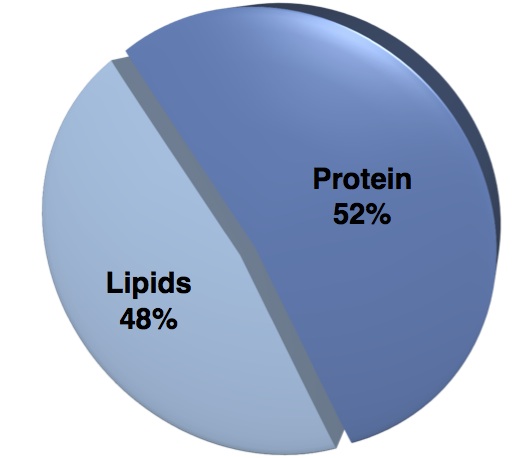Good Sources of Protein
are Easy to Find and Taste Great!
Including good sources of protein in your healthy diet plan is a must. However, this topic can be complicated, so let's clear up a few things so we're all on the same page.
Protein is not a shortfall nutrient in the modern diet. Most of us get plenty on a daily basis. Recently, it has been prescribed as something to focus on adding more of in our diets, mainly being praised for providing a feeling of fullness.
As we have seen previously, the amount of protein we intake is only half of the equation for a healthy diet. Good sources of protein should not only be high-quality, but also minimize factors associated with poor health.
An Example to Make Sense of Everything
Beef is touted as a protein powerhouse and considered a staple in the modern diet. The tenderloin, better known as a Filet Mignon, is a revered cut known for its tenderness and flavor.
Typically served as an 8 oz. cut, a Filet trimmed of all fat packs a colossal 62.5 grams of protein. Of the roughly 25 grams of fat, almost 40 % are saturated fats. This is a good source of protein. In fact, for someone who weighs about 155 lbs and has a sedentary lifestyle, this single filet would be enough protein for the entire day.
The issue is the balance of macronutrients.

If we rely only on beef as our chief source of protein in our diets, then we set ourselves up to create an imbalance of carbohydrates, protein, and fats in our diet. Too much fat, especially saturated fat, has been associated with many lifestyle diseases and increasingly poor overall health.
We expect animal-based foods to be good sources of protein, but you may be surprised at the some of the protein superfoods below.
KEY TAKEAWAY:
All food groups contain digestible and usable protein.
Good Sources of Protein Exist in Many Different Food Groups
The following lists contain the most protein-rich foods in each of their respective food groups, constructed in conjunction with the Daily Food Guide. Each food is ranked by the percentage of its calories which come from protein.
Lists are not based on grams of protein or calorie serving sizes because each of our calorie and protein needs are different. This measurement can put all foods on an even benchmark for comparison and is applicable to each one of our different caloric needs.
As a rule of thumb, we need a minimum of 10% of our calories as protein. This recommendation is supported by federal governments and global health agencies.
Vegetables and Fruits
All Vegetables are considered raw and Fruits are fresh unless otherwise specified. Nutritional values do vary slightly when being cooked, but for the most part protein will maintain its nutritional integrity. The more intense the cooking process, the more degradation of protein will result.
Leafy greens and mushrooms are true protein juggernauts. Notice the six vegetables whose makeup is over 50% protein... Pretty impressive!
|
|
Whole Grains, Legumes, and Nuts & Seeds
Whole Grains typically have between 10-20% of their calories as protein. Listed below are the best sources within this category as well as some numbers for the brans of the grains.
Legumes are awesome!
They almost always provide 20% or more of their calories in the form of protein. There are so many varieties to try and below are the best-of-the-best. The star performer are Lupini Beans, but take some caution. If not properly prepared, they can contain toxins for the body.
Soybeans come in at a distant second, but there are many products made from these special beans which will have a similar nutritional profile.
Lastly, enjoy our list of protein rich Nut & Seeds without salt, if possible.
|
|
|
Seafood, Wild Game, Poultry & Their Eggs
All the good sources of protein in the Seafood category are listed as cooked, either by steaming or broiling.
The Poultry, Wild Game, and Eggs category is very diverse. Eggs are considered the benchmark of an ideal protein source. Whole eggs of chickens and other egg-laying animals don't make the list because of the yolks that predominately fat-based, however, egg whites are a protein powerhouse.
Of the most readily accessible wild game meats, Deer (venison) meat is over 75% high-quality protein, more than any cut of beef or pork can provide!
When eating poultry, choose skinless, lighter meats in the breast region of the animal for the highest protein content.
|
|
Dairy and Livestock
All dairy products are derived from whole, full-fat milk, which has roughly 20% of its calories as protein. Compare that to Greek yogurt which has 330% more protein than whole milk.
Cheeses may vary depending on the processing and percentage of fat used, but in general cottage cheese, ricotta, mozzarella, and hard cheeses like parmesan and romano are good sources of protein.
In the Livestock category, Water Buffalo reigns supreme but can be hard to find. Goat meat can be found more readily, and can really add an interesting flavor to your meals.
Due to the fact beef and pork are the most common Livestock choices, we have ranked them by cuts rather than as a whole animal. All cuts have been trimmed of excess fat, and cooked without additional fats or oils added.
|
|
Make sure to include these good sources of protein on your shopping list along with the Daily Food Guide to make great choices for your healthy diet plan.
**As always, feel free to use the navigation below to backtrack and get an overview of Healthy Diet Mentor and our plan to get you on your way to a lifelong healthy diet.